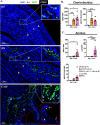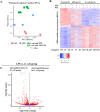The induction of preterm labor in rhesus macaques is determined by the strength of immune response to intrauterine infection
- PMID: 34495952
- PMCID: PMC8452070
- DOI: 10.1371/journal.pbio.3001385
The induction of preterm labor in rhesus macaques is determined by the strength of immune response to intrauterine infection
Abstract
Intrauterine infection/inflammation (IUI) is a major contributor to preterm labor (PTL). However, IUI does not invariably cause PTL. We hypothesized that quantitative and qualitative differences in immune response exist in subjects with or without PTL. To define the triggers for PTL, we developed rhesus macaque models of IUI driven by lipopolysaccharide (LPS) or live Escherichia coli. PTL did not occur in LPS challenged rhesus macaques, while E. coli-infected animals frequently delivered preterm. Although LPS and live E. coli both caused immune cell infiltration, E. coli-infected animals showed higher levels of inflammatory mediators, particularly interleukin 6 (IL-6) and prostaglandins, in the chorioamnion-decidua and amniotic fluid (AF). Neutrophil infiltration in the chorio-decidua was a common feature to both LPS and E. coli. However, neutrophilic infiltration and IL6 and PTGS2 expression in the amnion was specifically induced by live E. coli. RNA sequencing (RNA-seq) analysis of fetal membranes revealed that specific pathways involved in augmentation of inflammation including type I interferon (IFN) response, chemotaxis, sumoylation, and iron homeostasis were up-regulated in the E. coli group compared to the LPS group. Our data suggest that the intensity of the host immune response to IUI may determine susceptibility to PTL.
Conflict of interest statement
The authors have declared that no competing interests exist.
Figures








Similar articles
-
Timing of Histologic Progression from Chorio-Deciduitis to Chorio-Deciduo-Amnionitis in the Setting of Preterm Labor and Preterm Premature Rupture of Membranes with Sterile Amniotic Fluid.PLoS One. 2015 Nov 17;10(11):e0143023. doi: 10.1371/journal.pone.0143023. eCollection 2015. PLoS One. 2015. PMID: 26574743 Free PMC article.
-
Decidual neutrophil infiltration is not required for preterm birth in a mouse model of infection-induced preterm labor.J Immunol. 2014 Mar 1;192(5):2315-25. doi: 10.4049/jimmunol.1302891. Epub 2014 Feb 5. J Immunol. 2014. PMID: 24501200 Free PMC article.
-
Elevated expression and reduced phosphorylation of uterine RIG-I protein in a murine model of pathogenic preterm labor.Reproduction. 2025 Mar 12;169(4):e240299. doi: 10.1530/REP-24-0299. Print 2025 Apr 1. Reproduction. 2025. PMID: 39946161
-
15-epi-lipoxin A4 reduces the mortality of prematurely born pups in a mouse model of infection-induced preterm birth.Mol Hum Reprod. 2015 Apr;21(4):359-68. doi: 10.1093/molehr/gau117. Epub 2015 Jan 7. Mol Hum Reprod. 2015. PMID: 25567326 Free PMC article.
-
A Broad Spectrum Chemokine Inhibitor Prevents Preterm Labor but Not Microbial Invasion of the Amniotic Cavity or Neonatal Morbidity in a Non-human Primate Model.Front Immunol. 2020 Apr 30;11:770. doi: 10.3389/fimmu.2020.00770. eCollection 2020. Front Immunol. 2020. PMID: 32425945 Free PMC article.
Cited by
-
Amnion responses to intrauterine inflammation and effects of inhibition of TNF signaling in preterm Rhesus macaque.iScience. 2023 Oct 6;26(11):108118. doi: 10.1016/j.isci.2023.108118. eCollection 2023 Nov 17. iScience. 2023. PMID: 37953944 Free PMC article.
-
The hormonal control of parturition.Physiol Rev. 2024 Jul 1;104(3):1121-1145. doi: 10.1152/physrev.00019.2023. Epub 2024 Feb 8. Physiol Rev. 2024. PMID: 38329421 Free PMC article. Review.
-
Clarithromycin prevents preterm birth and neonatal mortality by dampening alarmin-induced maternal-fetal inflammation in mice.BMC Pregnancy Childbirth. 2022 Jun 20;22(1):503. doi: 10.1186/s12884-022-04764-2. BMC Pregnancy Childbirth. 2022. PMID: 35725425 Free PMC article.
-
The immunobiology of preterm labor and birth: intra-amniotic inflammation or breakdown of maternal-fetal homeostasis.Reproduction. 2022 Jun 20;164(2):R11-R45. doi: 10.1530/REP-22-0046. Reproduction. 2022. PMID: 35559791 Free PMC article. Review.
-
Evaluating impacts of the trichloroethylene metabolite S-(1,2-dichlorovyinyl)-L-cysteine on transcriptomic responses and cytokine release in a macrophage model: implications for pregnancy outcomes.J Immunotoxicol. 2025 Dec;22(1):2522041. doi: 10.1080/1547691X.2025.2522041. Epub 2025 Jul 3. J Immunotoxicol. 2025. PMID: 40607769
References
-
- Combs CA, Gravett M, Garite TJ, Hickok DE, Lapidus J, Porreco R, et al.. Amniotic fluid infection, inflammation, and colonization in preterm labor with intact membranes. Am J Obstet Gynecol. 2014;210(2):125 e1–e15. - PubMed
-
- Martin JA, Hamilton BE, Osterman MJ, Driscoll AK, Drake P. Births: Final Data for 2016. Natl Vital Stat Rep. 2018;67(1):1–54. - PubMed
Publication types
MeSH terms
Substances
Grants and funding
LinkOut - more resources
Full Text Sources
Medical
Molecular Biology Databases
Research Materials

